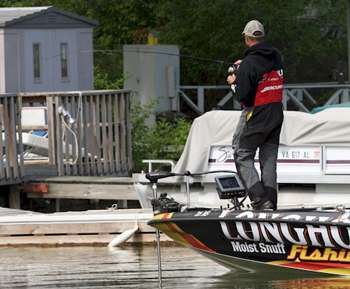
Living close to the shores of Oklahoma/Texas border impoundment Lake Texoma, Elite Series pro Jeff Kriet has become a student of dock fishing. With the knowledge acquired from years of pinpointing productive dock patterns on southeast Oklahoma fisheries, Kriet knows that not all docks are created equal.
Thanks largely to his understanding of how bass position themselves around the most prominent cover, Kriet is currently in the midst of another stellar season on the Elite Series. "The whole deal when you're fishing docks is that you've got to be paying attention to where your bites are coming from," he points out.
"If I don't know what the bass are relating to on the dock, I'm going to fish the entire dock and just pick it to pieces."
Starting at the front poles, Kriet explains that he works his way around the dock, pinpointing any likely ambush point from which a bass might spring. "I'm going to fish the entire dock — all the shady spots, and even the walkways," he explains.
"When I'm fishing docks, I'm paying attention to everything, from how my bait's falling to how the shade is lining up — every little thing could be a key to triggering a bite."
During the spring of the year, when bass are actively spawning or looking for a likely area in which to spawn, Kriet explains that the backside of docks offer the perfect nesting area. "This time of the year, I'm always going to be looking around the backs of docks," he says.
"When they're spawning, you can't fish too shallow. So from the bank to the first or second pole of the walkways is going to be prime."
During other times of the year, when bass are less predictable, Kriet says that the "all around" approach to dock patterning pays off — but you have to be thorough. "You have to cover that dock from one end of the other," he says.
"Once I start getting a few bites, I'll usually have a pretty good idea of how they're positioning. That's what I'm going to push from there on."
Aside from knowing where bass are holding on each dock, it's also imperative to understand that not all docks will hold bass. "After you've fished a few of them — say from the mouth of a pocket to the back — and you've gotten a few bites, you'll be able to look back and identify which docks your bites came from," he says.
"A lot of times it's a quantity versus quality deal, and you can burn so much time fishing the wrong docks in the wrong part of a cove."
Pattern fishing is all about duplication, and as Kriet explains, there are few opportunities that offer a better illustration of this than dock patterns. "You can get so specific with a dock pattern," he says.
"It might be that they're only holding on docks located in the middle of coves, or maybe they're only on the inside corner of each dock. There might be 40 docks in a particular cove, but by knowing these things, you've eliminated all but a dozen of them.
"If you've paid attention, you can run a dock pattern all over the lake," he says.
"I'm not going to say that I won't mix it up a little bit if I'm running a pattern to see if I can't distinguish a more subtle pattern inside it, but for the most part, if I'm convinced they're on a specific portion of the dock within a specific portion of a cove or creek, I'm going to run it all over the lake."




